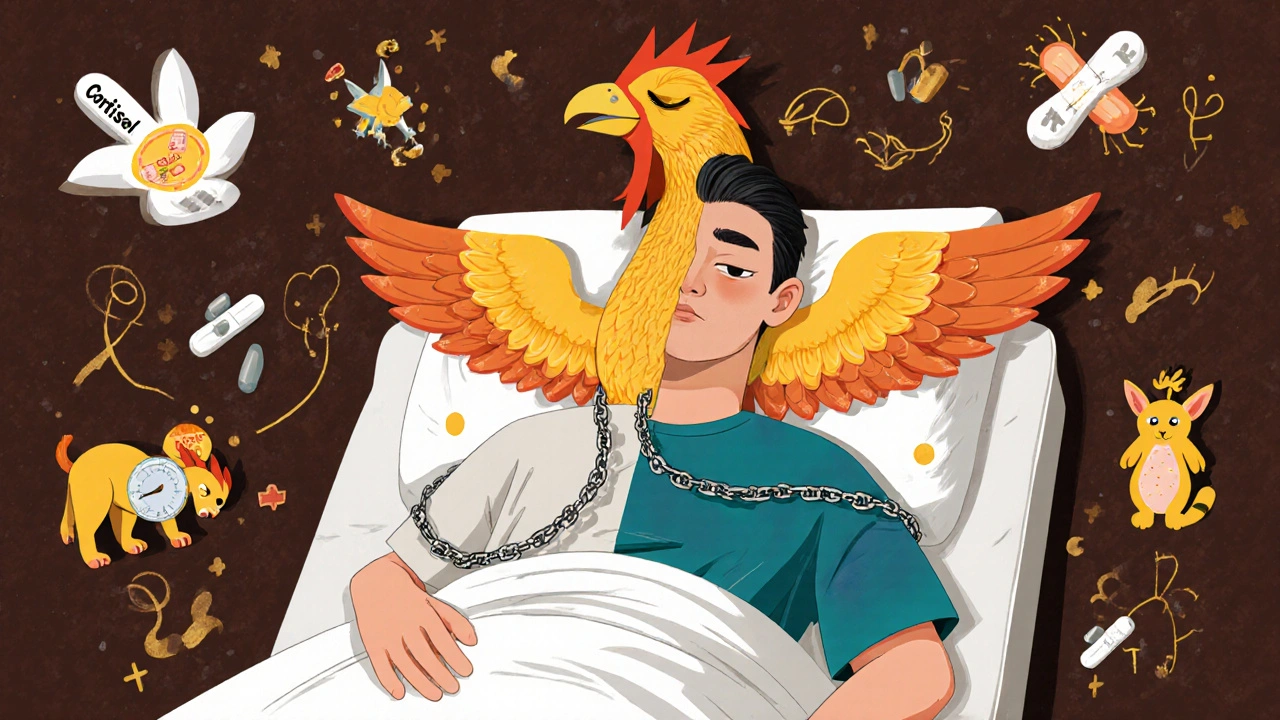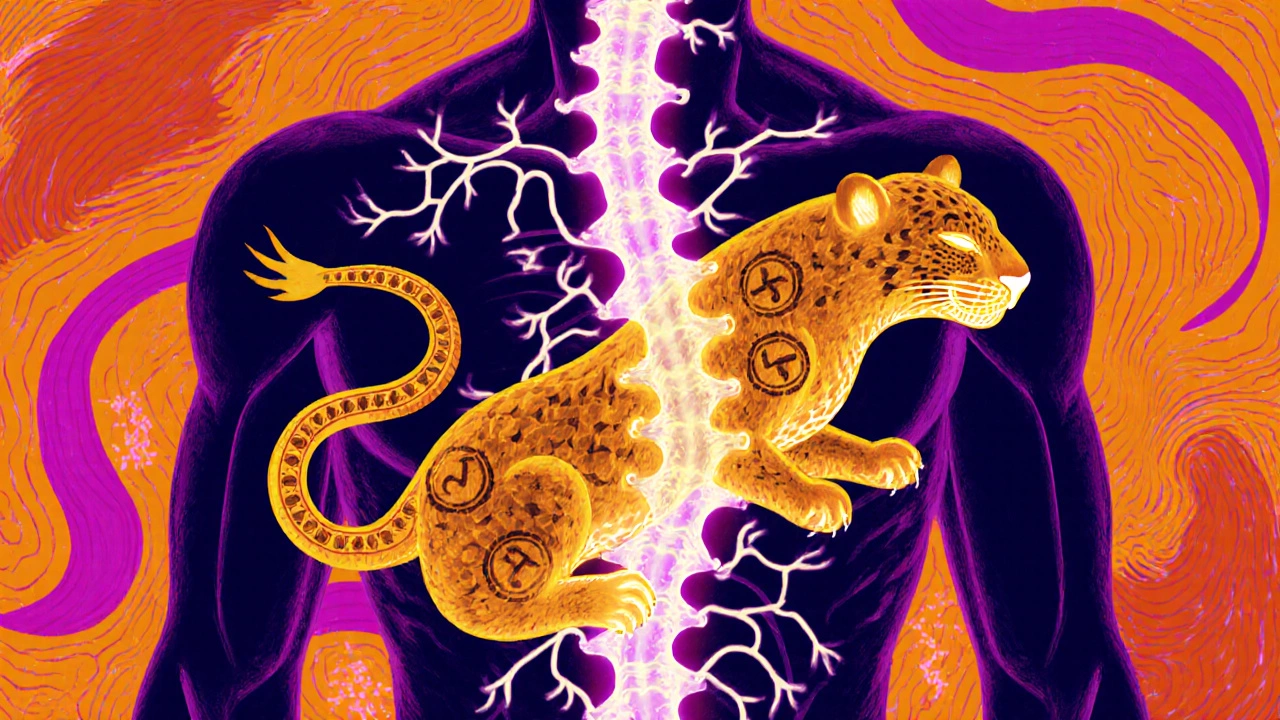Most people know opioids can cause constipation, drowsiness, or addiction. But few know that long-term opioid use can quietly shut down your body’s stress response system - leading to a condition so dangerous it can kill you if missed. This is opioid-induced adrenal insufficiency (OIAI), a rare but real side effect that’s being overlooked by doctors and patients alike.
What Happens When Opioids Silence Your Stress Hormones
Your body has a built-in alarm system called the HPA axis - short for hypothalamic-pituitary-adrenal. When you’re under stress - whether from injury, infection, surgery, or even emotional shock - this system kicks in. The hypothalamus sends a signal to the pituitary, which tells the adrenal glands to pump out cortisol. That’s your body’s natural steroid. It keeps your blood pressure up, your blood sugar stable, and your immune system in check.
Opioids - whether it’s oxycodone, hydrocodone, morphine, or methadone - interfere with this chain. They bind to receptors in the brain and block the signals that tell your adrenal glands to make cortisol. Over time, your body forgets how to produce enough on its own. The adrenal glands aren’t damaged. They’re just being told to sit still. That’s why OIAI is called secondary or tertiary adrenal insufficiency - it’s not the glands failing. It’s the brain’s command center going silent.
Who’s at Risk?
You don’t need to be a heavy drug user to be at risk. The danger starts with chronic use. A 2023 study found that about 5% of the U.S. population is on long-term opioid therapy. That’s millions of people. And among them, up to 5% develop OIAI - meaning roughly 1 in 20 people on chronic opioids could have this hidden problem.
The risk climbs sharply with dose. If you’re taking more than 20 morphine milligram equivalents (MME) per day, your chances jump. One study of 162 adults on opioids for at least 90 days found that those taking over 20 MME had a 5% rate of adrenal insufficiency. Another study showed that people on high-dose opioids were over 20 times more likely to fail adrenal function tests than those not taking opioids.
It’s not just cancer patients. We’re talking about people with chronic back pain, arthritis, or even post-surgical recovery. One case report described a 25-year-old man with chronic pancreatitis who developed adrenal failure after months of methadone. He wasn’t addicted. He wasn’t overdosing. He was just following his doctor’s orders.
Why This Is So Dangerous
The scariest part? OIAI often has no warning signs - until it’s too late.
Fatigue, nausea, dizziness, low blood pressure, muscle weakness - these are all symptoms of adrenal insufficiency. But they’re also symptoms of almost every other chronic illness. If you’re already in pain, already tired, already on meds, these signs get dismissed as part of the background noise.
But when stress hits - an infection, an accident, a surgery - your body has no cortisol reserve. No backup. No emergency response. That’s when an Addisonian crisis happens. Blood pressure crashes. You go into shock. You can die within hours if you don’t get emergency steroids.
One case study showed a young man on methadone developed high calcium levels after a hospital stay. Doctors thought it was a tumor. Only after digging deeper did they realize his cortisol was barely measurable. Once he got IV steroids and his opioids were tapered, his calcium returned to normal. His adrenal function came back - but only because someone finally looked.

How It’s Diagnosed
There’s no blood test you can take at your pharmacy. Diagnosis requires a specific stimulation test - the ACTH stimulation test. You get a shot of synthetic ACTH. Then your cortisol levels are checked at 30 and 60 minutes.
A normal response is a cortisol level above 18 mcg/dL (500 nmol/L). If your peak is below that, and your morning cortisol is under 3 mcg/dL (100 nmol/L), you likely have OIAI. Some newer studies suggest even lower thresholds might be needed, but this is the current standard.
And here’s the catch: you can’t just test cortisol alone. Many people on opioids have low morning cortisol but still respond to stress. That’s why the stimulation test matters. It tells you if your adrenals can still wake up - or if they’ve been put to sleep for good.
It’s Reversible - But Only If Caught
The good news? OIAI isn’t permanent. Once you stop or slowly reduce your opioid dose, your HPA axis usually wakes up again. In the case of the 25-year-old man on methadone, his cortisol levels returned to normal within months after stopping the drug.
But tapering must be done carefully. Cortisol has a 90-minute half-life. If you stop opioids too fast, your body can’t ramp up production fast enough. That’s why doctors need to monitor you and sometimes give temporary steroid replacement during withdrawal.
And no - opioids don’t affect aldosterone. That means your salt and potassium levels usually stay normal. This isn’t Addison’s disease from adrenal damage. It’s a brain signal problem. That’s why treatment is simple: replace cortisol, taper opioids, and wait for your body to relearn how to make its own.

What Doctors Should Be Doing
Right now, most pain clinics don’t screen for this. Guidelines don’t require it. But experts are sounding the alarm. Patel et al. (2024) wrote that clinicians need a "high index of suspicion" for anyone on long-term, high-dose opioids - especially if they’re feeling unusually tired, dizzy, or nauseous without clear cause.
The American Medical Association’s Ed Hub recommends testing anyone on chronic opioid therapy above 20 MME daily who shows signs of adrenal problems. That’s a clear, actionable rule. Yet few doctors follow it.
And here’s the bigger issue: we don’t know the full scope. Most data comes from small studies. We don’t have national screening programs. We don’t know if fentanyl or tramadol carry the same risk as morphine or oxycodone. We need larger, long-term studies. But until then, caution is the only safe approach.
What You Should Do
If you’ve been on opioids for more than three months - especially at doses over 20 MME - and you feel constantly tired, weak, or dizzy, ask your doctor about adrenal insufficiency. Don’t wait until you’re in crisis.
Bring up the ACTH stimulation test. Ask if your cortisol levels have ever been checked. If your doctor says it’s too rare to worry about, share the research. Studies from the Journal of Clinical Endocrinology & Metabolism and Frontiers in Endocrinology are clear: this isn’t theoretical. It’s happening.
If you’re being tapered off opioids, make sure your doctor plans for adrenal recovery. Don’t assume your body will bounce back on its own. Ask if temporary steroid cover is needed during the transition.
And if you’re a caregiver for someone on long-term opioids - watch for sudden drops in energy, fainting, confusion, or vomiting. These aren’t just "bad days." They could be the first signs of a life-threatening crisis.
The Bigger Picture
Opioids were meant to help people manage pain. But we’ve learned too late that they come with hidden costs. OIAI is just one of them. Others include hormonal imbalances, depression, and sexual dysfunction. What ties them together? A system designed to relieve pain without fully accounting for how it reshapes the body’s biology.
The opioid epidemic didn’t just cause overdoses. It caused silent, slow-burning damage to millions of bodies. OIAI is one of the most dangerous because it’s invisible - until it’s fatal.
We need better screening. We need clearer guidelines. We need doctors to look beyond the pain and ask: "What else is this drug changing?"
For now, the best defense is awareness. If you’re on long-term opioids, don’t assume you’re safe just because you’re not addicted. Your body might be quietly running on empty - and it needs you to speak up before it collapses.

